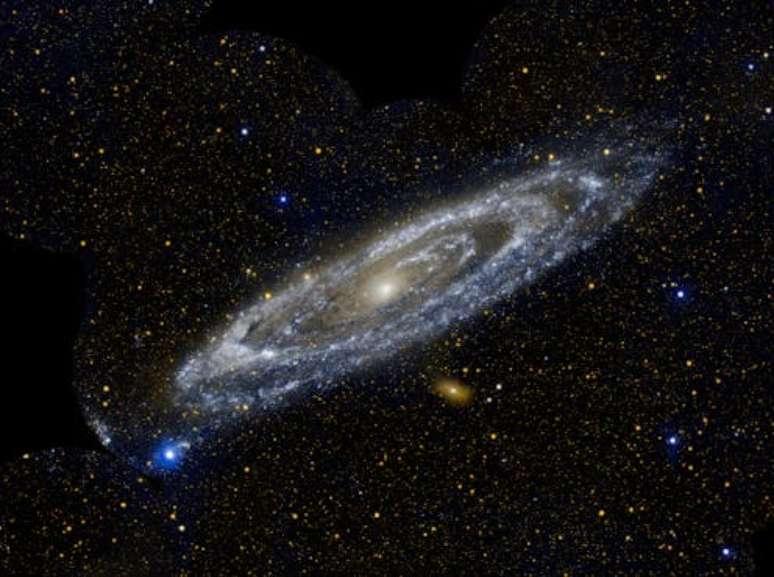In 1924, astronomer Edwin Hubble realized that two objects were too distant to be within our galaxy, constituting galaxies separate from the Milky Way.
Sunday 23 November 1924, 100 years ago, readers who browsed the sixth page of New York Times I found an interesting article among several large fur advertisements. The headline read: Spiral Nebulae Discovered as Star Systems: “Dr. Hubbell (sic) Confirms Opinion That They Are ‘Island-Universes’, Similar to Ours.”
The American astronomer at the center of the article, Dr. Edwin Powell Hubble, was probably confused by the misspelling of his name. But the story detailed a groundbreaking discovery: Hubble had discovered that two spiral-shaped nebulae, objects composed of gas and stars, previously thought to reside in our galaxy, the Milky Way, lay outside it.
These objects were actually the Andromeda and Messier 33 galaxies, the closest large galaxies to our Milky Way. Today, several trillion galaxies are estimated to fill the Universe, based on observations of tens of millions of galaxies.
Four years before Hubble’s announcement, an event called “The Great Debate” took place in Washington DC between American astronomers Harlow Shapley and Heber Curtis. Shapley had then recently demonstrated that the Milky Way was larger than the previous measurement. Shapley claimed that it could host spiral nebulae within it. Curtis, on the other hand, argued for the existence of galaxies beyond the Milky Way.
In retrospect, and by ignoring some details, Curtis won the debate. However, the method used by Shapley to measure distances in the Milky Way was fundamental to Hubble’s discovery, and was inherited from the work of a pioneering American astronomer: Henrietta Swan Leavitt.
Measure the distances of the stars
In 1893, the young Leavitt was hired as a “computer” to analyze images from telescope observations at the Harvard College Observatory in Massachusetts. Leavitt studied photographic plates of telescopic observations of another galaxy, called the Small Magellanic Cloud, made by researchers at the observatory.
Leavitt was looking for stars whose brightness changed over time. Of over a thousand variable (changing) stars, he identified 25 that belonged to a type known as Cepheids, publishing the results in 1912.
The brightness of Cepheid stars changes over time so much so that they appear to pulsate. Leavitt found a consistent relationship: Cepheids that pulsed more slowly were intrinsically brighter (brighter) than those that pulsed more rapidly. This has been called the “period-luminosity relationship”.
Other astronomers realized the importance of Leavitt’s work: the relationship could be used to calculate our distances to the stars. While a student at Princeton University, Shapley used the period-luminosity relationship to estimate the distances of other Cepheids in the Milky Way. This is how Shapley arrived at his then-new estimate of the size of our galaxy.
But in order to be certain about distances within our galaxy, astronomers needed a more direct way to measure distances to Cepheids. The stellar parallax method is another way to measure cosmic distances, but it only works for nearby stars. As Earth orbits the Sun, a nearby star appears to move relative to more distant background stars. This apparent motion is known as stellar parallax. Using the angle of this parallax, astronomers can calculate the distance of a star from Earth.
Danish researcher Ejnar Hertzsprung used stellar parallax to obtain distances to a handful of nearby Cepheid stars, helping to calibrate Leavitt’s work.
The article by New York Times it highlighted the “large” telescopes at Mount Wilson Observatory near Los Angeles, where Hubble worked. The size of a telescope is generally judged by the diameter of its primary mirror. With an 8-foot-diameter mirror to collect light, the Hooker Telescope on Mount Wilson was the largest telescope of its time.
Large telescopes are not only more sensitive to the resolution of galaxies, but also create sharper images. Edwin Hubble was therefore in a good position to make his discovery. When Hubble compared his photographic plates taken with the 100-inch telescope with those taken on previous nights by other astronomers, he was thrilled to see that a bright star appeared to change brightness over time, as expected for a Cepheid.
Using Leavitt’s calculations, Hubble found that the distance to his Cepheids exceeded the size Shapley calculated for the Milky Way. Over the next few months, Hubble examined other spiral nebulae as he searched for other Cepheids to measure distances. News of Hubble’s observations was spreading among astronomers. At Harvard, Shapley received a letter from Hubble detailing his discovery. He handed it to fellow astronomer Cecilia Payne-Gaposchkin, commenting, “Here is the letter that destroyed my universe.”
Expansion of the Universe
In addition to estimating the distance to a galaxy, telescopes can also measure how quickly a galaxy is approaching or receding from Earth. To do this, astronomers measure a galaxy’s spectrum: the different wavelengths of light coming from it. They also calculate an effect known as the Doppler shift and apply it to this spectrum.
The Doppler shift occurs for both light and sound waves; It is responsible for increasing the siren’s pitch when an emergency vehicle approaches and then decreasing it when it passes you and moves away. When a galaxy moves away from Earth, features in the spectrum known as absorption lines have longer wavelengths than they would if they were not moving. This is due to the Doppler shift and we say that these galaxies have been “redshifted”.
Starting in 1904, American astronomer Vesto Slipher used the Doppler technique with a 24-inch telescope at the Lowell Observatory in Flagstaff, Arizona. He discovered that the nebulae were either redshifted (moving away) or blueshifted (traveling towards us). Slipher discovered that some nebulae were receding from Earth at speeds of up to a thousand kilometers per second.
Hubble combined Slipher’s measurements with its distance estimates for each galaxy and discovered a relationship: the further away a galaxy is from us, the faster it is moving away from us. This can be explained by the expansion of the Universe from a common origin, which would ironically become known as the “Big Bang”.
The announcement made 100 years ago cemented Hubble’s place in the history of astronomy. His name would later be used for one of the most powerful scientific instruments ever created: the Hubble Space Telescope. It seems incredible how, in the course of just five years, our understanding of the Universe has come into focus.

Jeffrey Grube does not consult with, work for, own shares in, or receive funding from any company or organization that would benefit from the publication of this article, and has not disclosed any relevant relationships beyond his academic position.
Source: Terra
Rose James is a Gossipify movie and series reviewer known for her in-depth analysis and unique perspective on the latest releases. With a background in film studies, she provides engaging and informative reviews, and keeps readers up to date with industry trends and emerging talents.





-to4l92e9v7fo.jpg)

